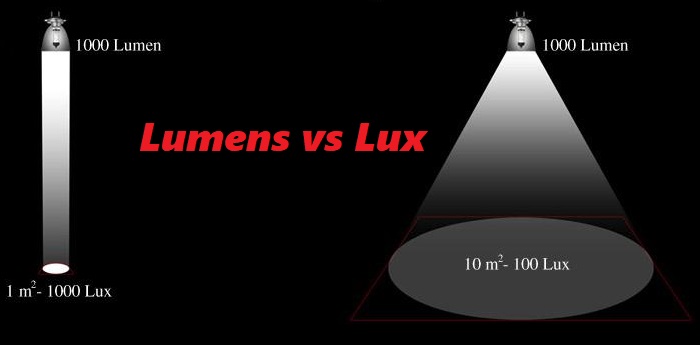If you are learning about the brightness of a light bulb, you will come across two units: lumens vs lux. Both are related to brightness but still have their differences.
- What Is Lux?
- How much Lux illuminance should you choose?
- What Is Lumens?
- Determine the brightness of the lamp through the Lumen index
- Which lamp line to choose for an energy-free lighting solution?
- How to choose the Lumen index to match each space in the house?
- What Is The Difference Between Lumens And Lux?
- Tips when Buying Led Lights
- Classification of lighting angle
- Light intensity
- Color rendering index CRI
What Is Lux?
Lux (lx) is the SI unit for illuminance, it is the total luminance over a surface area as described photometrically. Lux means luminous flux or luminous intensity Lumen per square meter (lm/m2) and is commonly referred to as illuminance.
How much Lux illuminance should you choose?
Although for large rooms you should prioritize choosing high illuminance, not all rooms need the same brightness but need to be based on specific lighting purposes.
For example, rooms that are mainly used for storage such as warehouses, basements for parking, etc, will need relatively low light levels; while conference rooms, living rooms, showrooms, work environments will require good quality of light so much higher brightness levels will be required.
- 100 Lux – This light level is suitable for lighting in elevators, corridors, and stairs. Most warehouse and storage areas will also require this minimum level of light. You won’t want to read a book on this light level, but it’s good enough for ambient lighting.
- 150 Lux – Restrooms and technical engine rooms require this level of light. This illuminance is suitable for simple activities.
- 200 Lux – Entrance and hallway areas require this level of light, and it is also the bare minimum for restaurant dining areas.
- 300 Lux – The assembly area and communal house need at least 300 Lux illuminance.
- 500 Lux – Retail space should have this minimum, as should office space in general. This illuminance will be suitable for prolonged work on computers, machines, reading, studying…
- Over 500 Lux – If you need to light an area with complex work to be performed, then a very high Lux value is required. Especially for spaces that require detailed and meticulous work, you can choose illuminance up to 2,000 Lux. For most general lighting purposes an illuminance of 500 lux will suffice.
What Is Lumens?
Lumen is defined as the total amount of visible light emitted from a light source. Lumen is related to Lux where one lux is one lumen per square meter.
Determine the brightness of the lamp through the Lumen index
Many people when buying lamps are only interested in the Watts index (lamp power), but Watts only measures the energy used, without knowing the amount of light emitted and are often mistaken for the higher the number of W lights brighter. But, you should care about the Lumens index when you want to determine the brightness of the lamp.
Which lamp line to choose for an energy-free lighting solution?
If you are still wondering which light bulb saves more electricity, the answer is solar lights. Thanks to the operating principle of absorbing sunlight, storing and converting it into electricity for lighting, you do not have to pay a dime.
With only 1 initial investment, with a lifespan of over 50,000 hours, the simpler installation will be a great choice for many families.
How to choose the Lumen index to match each space in the house?
For indoor spaces often require soft light, to create relaxation, bring comfort to users. Therefore, you cannot choose headlights and LED lights with a Lumen intensity that is too large from a few thousand to several tens of thousands of Lumen. This will have a great impact on vision, eye health. The advice for this case is to choose a light with a lumen of 300 – 600.
For outdoor spaces that need to perform important tasks such as production work, lux or lumen ensuring security such as lighting gate yards, village roads, etc, it is recommended to choose a high Lumen index of about 6000 Lumen or more.
What Is The Difference Between Lumens And Lux?

Lux and lumen are quite confusing as both are measures of the light of a bulb, but lux has to consider the area of space while lumens do not.
Imagine you buy a 600 lumen light bulb and install it in a room with an area of 10m2, the light will have an illuminance = 60 Lux. However, also using the same lumen bulb in a larger room with a surface area of 20m2, the illuminance will be reduced to 30 Lux.
So it can be seen that, with the larger the room that needs lighting, you should choose the bulb with the higher illuminance. This is an important note that is very useful when choosing the right and highly effective lighting equipment.
Lux is imperative to know the measured lights to shows up explicitly on a surface region. This is a significant measurement on the off chance that you need to realize how brilliant the surface will be. Like ledges, understanding materials, or photographic subjects.
To lumens versus lux, you should know lux is a proportion of the measure of light on a specific surface territory and can be the aftereffect of different bulbs and even sunlight blended.
Then again, lumens are critical to realizing how much light a light source discharges. This helps look at the aggregate sum of light a bulb discharges yet is dependent upon its light dissemination and spatial measurements.
The nearer to the light source, the higher the lux estimation. This is because of light dispersing as an individual move from the light source.
Consequently, when you take a gander at a lux rating for a bulb, you ought to consistently ensure there is a hole included. For instance, you may see “1000 lux at 4 feet”. On the off chance that you just see the lux rating, you will not know where this is estimated and you will not have the option to make a sensible examination.
For most directional light sources like LEDs, the focal point of the pillar normally has the most noteworthy lux rating. As you move away from the middle, the lux will diminish.
In short: Both the units used to measure light are lux the same as lumens!
Tips when Buying Led Lights
Besides Lux Or Lumens, Some Parameters You Need To Pay Attention To When Buying Led Lights.
Lighting performance
Lighting efficiency is the luminous efficiency of a lamp, calculated as the ratio between luminous flux and power consumed by the lamp. The unit of measurement of luminous efficiency is lumen/W.
Lamps with high luminous efficiency are lamps that give a large luminous flux and consume less power. That is, the higher the luminous efficiency index, the more energy-saving the lamp is. The biggest advantage of LED lights is their high luminous efficiency.
Lighting angle
The lighting angle is the angle between two faces with a minimum luminous intensity equal to 50% of the strongest luminous intensity in the central bright area.
The easiest way to identify the angle of light is by using a light fixture on the wall. You will easily notice different areas of light, large and small, and different strengths and weaknesses.
The light sources are the same, but different projection angles will produce images of different bright areas. The larger the lighting angle (the more radiant), the smaller the center light intensity and the wider the light area.
Classification of lighting angle
There are 3 basic types of projection angles, each with a different angle for a separate lighting effect, suitable for different uses.
Narrow projection angle: 3, 5, 8
The above narrow beam lights are usually designed specifically for column lighting, creating accents for the exterior of the house or works at night.
Average projection angle: 10, 24, 38
These projection angles are common projection angles for spotlights (spotlights) when we are building ideas of point, impression, or indirect light.
These angled lamps are suitable for installation in the bedroom – where you need to create a private and relaxing space because they do not cause glare or discomfort when lying down.
Wide projection angle: >100
This projection angle creates light that spreads evenly with a wide light area, so these lamps are suitable for installation in common living spaces such as living rooms and kitchens.
And high-power LED lights such as LED street lights, LED floodlights, LED factory lights, etc all require a wide angle of light to illuminate a large area.
Light intensity
Luminance is the basic optical quantity in the SI international system of measurement. The unit of light intensity is the candela (cd). Luminous intensity is the energy emitted from a light source in a certain direction.
Specifically as follows: 1 candela is the luminous intensity that a light source emits 1 lumen isotropic at a solid angle. A 1 cd light source will emit 1 lm over an area of 1 m2 at a distance of 1 m from the center of the light source.
Color rendering index CRI
Color Rendering Index (CRI) is an index that reflects the fidelity of the color of an illuminated object. The higher the CRI value, the more vivid and true the color of the illuminated object will be. CRI index is very important when evaluating an LED product, is the lighting good or not?
The color rendering index of sunlight (white light) is taken as a standard to compare and determine the color rendering index of other light sources. The Conventional CRI of sunlight is 100. Light sources similar to sunlight also have CRI = 100 are incandescent light, halogen light.
Conclusion
Hopefully, through this article, you can understand the Lux compared to lumens, basic parameters of LED lights so that you can easily choose to buy the most suitable and quality products for your purposes. If you have any questions, please contact us immediately to receive the most optimal lighting solutions!






